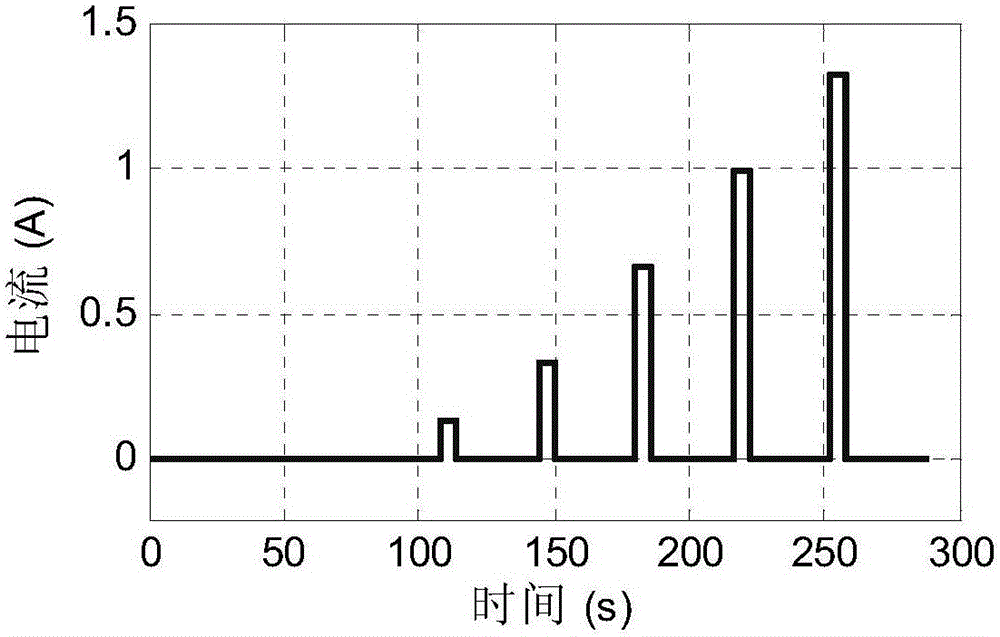Long-life rapid charging method for lithium ion battery
A lithium-ion battery and fast charging technology, which is applied in the field of new energy research, can solve the problems of low charging efficiency and large battery damage, and achieve the effects of high charging efficiency, prolonging cycle life and fast charging
- Summary
- Abstract
- Description
- Claims
- Application Information
AI Technical Summary
Problems solved by technology
Method used
Image
Examples
specific Embodiment approach 1
[0023] Specific implementation mode one: refer to Figure 1 to Figure 5 Describe this embodiment in detail, a kind of lithium-ion battery long-life fast charging method described in this embodiment, it comprises the following contents:
[0024] Step 1, establishing an improved single-particle model for lithium-ion batteries;
[0025] Step 2, using the method of excitation response analysis to obtain the mechanism parameters of the battery in the improved single particle model in step 1;
[0026] Step 3. According to the mechanism parameters of the battery, the lithium intercalation rate on the surface of the negative electrode active material of the battery is obtained;
[0027] Step 4: Comparing the lithium intercalation rate on the surface of the negative active material of the battery with the set threshold, charging with a high current of 2C at the beginning of charging, and stopping charging when the lithium intercalation rate on the surface of the negative active partic...
Embodiment
[0035] The experimental battery uses Sanyo's UR14500P lithium cobalt oxide battery with a nominal capacity of 840mAh and a platform voltage of 3.7V. Select three batteries with similar performance, set up three groups of comparison experiments, and use different charging methods to charge respectively. The first group adopts the fast charging method in the present invention, that is, the combination mode of 2C high-rate charging and pulse charging, and the second group uses Large current 2C constant current and constant voltage charging, the third group performs traditional 1C constant current and constant voltage charging.
[0036] attached Figure 7-10 The comparison curves of the charging current, battery terminal voltage, lithium ion concentration on the negative electrode surface, and battery SOC of the three charging methods are given respectively. Figure 7is the charging current curve. Different from the constant current and constant voltage charging mode, the chargin...
specific Embodiment approach 2
[0038] Specific embodiment 2: This embodiment is a further description of a long-life fast charging method for lithium-ion batteries described in specific embodiment 1. In this embodiment, in step 1, an improved single-event model is established for lithium-ion batteries for:
[0039] According to the formula:
[0040] the y avg =y 0 +It / Q p (Equation 1) and x avg =(1-y ofs -y avg ) Q p / Q n (Formula 2),
[0041] Obtain the average lithium ion concentration y inside the positive electrode active particles avg and the average lithium ion concentration inside the negative electrode active particle x avg ,
[0042] In the formula, Q p and Q n They are the capacity of the positive electrode and the negative electrode respectively, I is the load current, it is stipulated that the discharge is positive, t is the time, and y 0 is the initial lithium intercalation concentration fraction of the positive electrode of the battery, y ofs It is the ratio offset of positive a...
PUM
 Login to View More
Login to View More Abstract
Description
Claims
Application Information
 Login to View More
Login to View More - Generate Ideas
- Intellectual Property
- Life Sciences
- Materials
- Tech Scout
- Unparalleled Data Quality
- Higher Quality Content
- 60% Fewer Hallucinations
Browse by: Latest US Patents, China's latest patents, Technical Efficacy Thesaurus, Application Domain, Technology Topic, Popular Technical Reports.
© 2025 PatSnap. All rights reserved.Legal|Privacy policy|Modern Slavery Act Transparency Statement|Sitemap|About US| Contact US: help@patsnap.com



